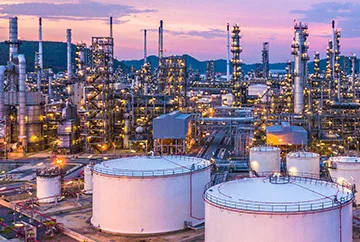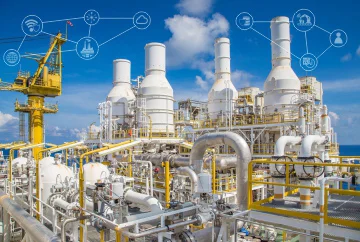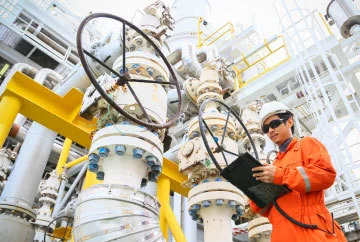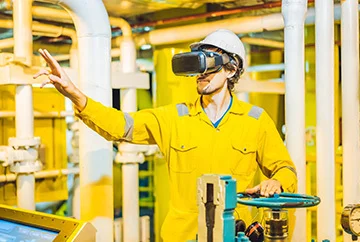Benefits of Robotics in the Oil and Gas Industry
As per a
report by Robotics Tomorrow, the annual robotics revenue can grow between 15% and 20% up to 2028. Two of the key drivers behind this growth would be flexibility and innovation. The oil industry is in the same line and requires significant transformation to keep pace with the other sectors and remain relevant.
In the 1980s, the oil and gas industry first adopted digital technologies. The focus was to improve their understanding of reservoir resource and production potential, boost marginal operational efficiencies, and improve health and safety factors. Unfortunately, even though much data was being produced, the industry barely did anything with it until the last few years.
Click to zoom in
Now that the transformation is finally happening, here are five top perceivable benefits from the inculcation of robotics in the oil and gas industry -
Safer Rigs
On 6th July 1988, an incident shook the entire oil and gas industry. Yes, we are talking about Piper Alpha, an event that claimed 167 lives and destroyed a 14,000-tonne oil rig. While it remains one of the deadliest offshore oil rig calamities, robotics can help ensure that we minimize the chances of any such unwanted occurrences tormenting our lives again.
One way to ensure safer rigs is by allowing automation to be an integral part of the system. Given that offshore rigs do not require high flexibility, hard automation would be a safer bet.
Today, more and more manufacturers are leveraging their oil rigging structures by inculcating automated pipe-handling and tripping systems along with ADC (autonomous drilling control) systems, which eliminate continuous human intervention, thereby reducing the risk of lapses. In addition, it has allowed humans to visit the site once or twice a year and let the rig operate independently.
Higher Cost Savings
Offshore oil rigs have always suffered from higher costs because of many reasons, such as inclement weather, ensuring people working are safe and protected, and the presence of an emergency solution that can help them escape unscathed during an emergency.
So, if you minimize human presence in offshore rigs, we will already experience a significant cost reduction. While robotics help in achieving it, there are more ways it helps reduce cost costs.
With the help of
AI baked into these rigs, they use complex algorithms to map well, perform calculations, and make informed decisions, allowing them to drill longer without making costly mistakes. In addition, the ability to undertake real-time monitoring has enabled eliminate issues with manual handlings, such as production errors and concentration lapse.
Improved Operational Efficiency
In a perfect world, it should be possible for any third-party vendor to make a good algorithm on how to drill efficiently and how to do different work processes in the well. And it is happening quite a lot," says Per Ivar Halleland, Senior Expert, DNV GL.
In its present form, robotics do not necessarily put the best driller to shame, but given the
AI and ML chops at play, these machines are expected to learn fast and not repeat their mistakes. It would give them an edge in the long run. In addition, robotics-infused rigs are better at spotting data inconsistencies and potential shortcomings, allowing them to be proactive and take the requisite action before it is too late. It contributes to
improved operational efficiency for the oil and gas industry players.Frequent and Safer Inspection
The oil and gas industry uses underwater robots with an underwater docking system. These machines are capable of reaching areas that humans presently can only imagine. Plus, these are modular and come equipped with Ethernet connectivity, enabling them to maintain strong signals.
These have a self-contained battery system capable of operating without any mothership and also perform their routine inspection without harming the marine ecosystem. Furthermore, given the presence of underwater robots, rig handlers can be proactive and undertake frequent inspections, ensuring optimum safety and fewer breakdowns.
Improved Data Generation
Improved data and reports would be essential if the oil and gas industry wants to evolve successfully and undertake the steep transformation journey. While traditional methods, such as satellites, ROVs, and support ships, have worked amicably well, there is a need to look beyond them as they suffer from a myriad of bottlenecks.
With robotics, brands can now undertake advanced data analytics with the help of real-time data solutions, such as METOC (meteorology/oceanography), loss detection, and more, without incurring additional costs. These can propel them to develop advanced solutions that are sustainable and better equipped to handle the challenges that come their way.
Real-life Examples of Robotics in the Oil and Gas Industry
Now that we have discussed the probable applications and benefits of robotics in the oil and gas industry let us look at some real-life examples of how brands have been able to use robots for their offshore endeavors -
Spot From Boston Dynamics
Spot, a quadruped robot from Boston Dynamics, has been deployed once in the Norwegian Sea (Skarv FPSO) and another time in the deep-water Gulf of Mexico for a plethora of purposes. The former collected sensory readings, scans, and images and seamlessly shared them to the user's network. The latter was used as a substitute for human beings and was deployed in challenging offshore sites where it scanned for methane, identified potential leaks in deep water, and allowed the team to read gauges.
Taurob Inspector from Equinor and the Oil and Gas Technology Centre in Aberdeen
Another fantastic example of robotics in the oil and gas industry would be the Taurob Inspector created by Equinor and the Oil and Gas Technology Centre in Aberdeen in a joint partnership with ARGOS. The phenomenal piece of creation can take UHD images and videos, record sound, gather data, and even detect gas leaks. It has been tested at the Shetland gas plant, where it passed with flying colors, and the brands further want to deploy the solution at their offshore facilities.
Inspection Robots by Solinas Integrity
Solinas Integrity, an Indian startup, developed a fleet of robots that could inspect flow rates, help in pigging, and undertake pipe integrity assessments without taking a toll on structural safety. Its product line-up included -
- iPig, an inspection robot for assessing oil and gas pipelines,
- SEPoy for tank inspection,
- iGlobus for detecting oil and gas pipeline leaks, and
- Endobot for advanced leakage detection.







